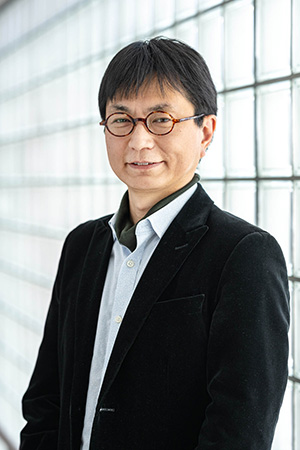
- HOME
- Genome Dynamics Project
Genome Dynamics Project
Elucidating mechanisms of genome inheritance and characterizing diseases caused by genome instability
Achievements in 2024
Our laboratory is dedicated to elucidating the mechanisms underlying chromosomal instability, a hallmark of cancer, using model organisms such as E.coli, Yeast, human cell lines and mouse. Chromosomal instability is characterized by the inability to accurately transmit genetic information to daughter cells. For example, the incorporation of erroneous bases by DNA polymerase during DNA replication and repair processes can result in a deterioration of both the quality and quantity of genomic information. BRCA1 and BRCA2, which are tumor suppressor genes, play a crucial role in the process of homologous recombination HR and these losses also cause alteration of genomic information. Intriguingly, while HR is essential for cell proliferation in all organs, mutations in BRCA1/2 selectively lead to breast and ovarian cancers. This phenomenon presents a paradox in cancer biology, as the ubiquitous requirement for HR across all tissues contrasts with the specific cancer types associated with BRCA1/2 deficiencies. Elucidating the underlying mechanisms for this tissue specificity could provide crucial insights into cancer development and potentially leads to targeted therapeutic strategies. Our research focuses on dissecting the mechanisms of chromosomal instability induced particularly by defects in DNA replication and repair processes, as well as the consequent changes in genome dynamics. The goals of our research team are as follows:
- 1) Elucidation of how chromosome instability affects three-dimensional structure of the genome
- 2) Investigation of how genome integrity is maintained
- 3) Understanding organization and topology of the genome
- 4) Understanding molecular mechanism of tumorgenesis caused by genome instability
Publications
Papers in 2024
- “Zheng Z, Yamada S (5/8), *Keeney S.” ,Reconstitution of SPO11-dependent double-strand break formation, bioRxiv. 2024 doi: 11.20.624382.
- “Iguchi T, Toma-Hirano M, Takanashi M, Masai H, *Miyatake S.” ,Loss of a single Zn finger, but not that of two Zn fingers, of GATA3 drives skin inflammation, Genes Cells 2024 Dec;29(12):1173-1189. doi:10.1111/gtc.13171.
- “Sagi T, Sadato D, Takayasu K, Sasanuma H, Kanoh Y, *Masai H.” RNA-DNA hybrids on protein coding genes are stabilized by loss of RNase H and are associated with DNA damages during S-phase in fission yeast, Genes Cells. 2024 Nov;29(11):966-982. doi: 10.1111/gtc.13157.
- “Chralton SJ, Flury V, Kanoh Y, Genzor AV, Kollenstart L, Ao W, Brogger P, Weisser MB, Adamus M, Alcaraz N, Delvaux de Fenffe CM, Mattiroli F, Montoya G, Masai H, Groth A, *Thon G.” The fork protection complex promotes parental histone recycling and epigenetic memory, Cell. 2024 Sep 5;187(18):5029-5047.e21. doi: 10.1016/j.cell.2024.07.017.
- “Kim S, Yamada S (2/4), *Keeney S”, Optimized methods for mapping DNA double-strand-break ends and resection tracts and application to meiotic recombination in mouse spermatocytes. bioRxiv. 2024 doi: 10:2024.08.10.606181.
- “Yamazaki K, Iguchi T, Kanoh Y, Takayasu K, Ngo TTT, Onuki A, Kawaji H, Oshima S, Kanda T, Masai H, *Sasanuma H”, Homologous recombination contributes to the repair of acetaldehyde-induced DNA damage. Cell Cycle. 2024 Feb;23(4):369-384. doi: 10.1080/15384101.2024.2335028.
- “Biller M, Kabir S, Boado C, Nipper S, Saffa A, Tal A, Allen S, Sasanuma H, Dréau D, Vaziri C, *Tomida J.”, REV7-p53 interaction inhibits ATM-mediated DNA damage signaling,Cell Cycle. 2024 Feb;23(4):339-352. doi: 10.1080/15384101.2024.2333227.
- “Shibata T, Ikawa S, Iwasaki W, Sasanuma H, Masai H, *Hirota K.” Homology recognition without double-stranded DNA-strand separation in D-loop formation by RecA. Nucleic Acids Res. 2024 Mar 21;52(5):2565-2577. doi: 10.1093/nar/gkad1260.
- “Kim S, Yamada S (2/11), *Keeney S.” The MRE11-RAD50-NBS1 complex both starts and extends DNA end resection in mouse meiosis. bioRxiv. 2024 doi: 17:2024.08.17.608390
- “You ZY, Hsiao HW, Yang CC, Goto H, *Masai H.” ,Phosphorylation inhibits intramolecular interactions, DNA-binding and protein interactions of Claspin through disordered/ structured conformation transition. bioRxiv. 2024 doi: https://doi.org/10.1101/2024.01.08.574761
